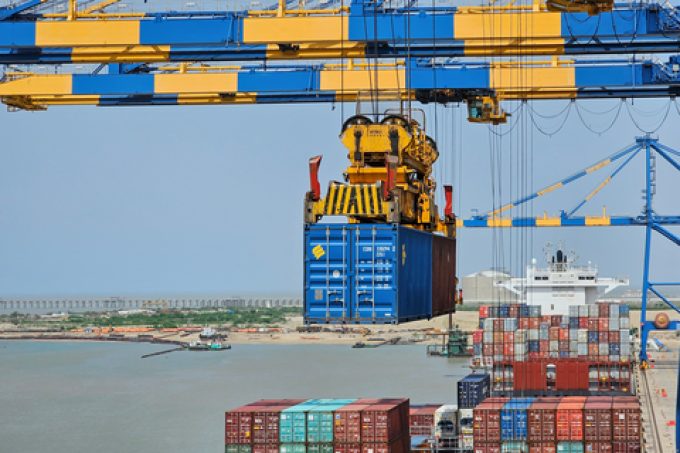Two winners from the Red Sea crisis: the shipping lines and Houthis
“Vessels ‘go dark’ to avoid Houthi attacks,” blared headlines as 2024 kicked in, and commercial ...
FDX: ABOUT USPS PRIVATISATIONFDX: CCO VIEWFDX: LOWER GUIDANCE FDX: DISRUPTING AIR FREIGHTFDX: FOCUS ON KEY VERTICALFDX: LTL OUTLOOKGXO: NEW LOW LINE: NEW LOW FDX: INDUSTRIAL WOESFDX: HEALTH CHECKFDX: TRADING UPDATEWMT: GREEN WOESFDX: FREIGHT BREAK-UPFDX: WAITING FOR THE SPINHON: BREAK-UP ALLUREDSV: BREACHING SUPPORTVW: BOLT-ON DEALAMZN: TOP PICK
FDX: ABOUT USPS PRIVATISATIONFDX: CCO VIEWFDX: LOWER GUIDANCE FDX: DISRUPTING AIR FREIGHTFDX: FOCUS ON KEY VERTICALFDX: LTL OUTLOOKGXO: NEW LOW LINE: NEW LOW FDX: INDUSTRIAL WOESFDX: HEALTH CHECKFDX: TRADING UPDATEWMT: GREEN WOESFDX: FREIGHT BREAK-UPFDX: WAITING FOR THE SPINHON: BREAK-UP ALLUREDSV: BREACHING SUPPORTVW: BOLT-ON DEALAMZN: TOP PICK

Container lines seem to be shelving plans to implement fresh rate increases on the India-US tradelane that has yielded them stronger-than-expected returns over the past two months.
Indeed, CMA CGM has delayed for the third time a peak season surcharge (PSS) it originally planned to implement in August until 1 October.
The French line has also reduced the PSS from the previously advertised $1,500 per container to $1,000, on shipments from the Indian subcontinent, Middle East, Red Sea and Egypt to the US east and Gulf coasts.
Similarly, Hapag-Lloyd has a $1,000 per container general rate increase (GRI) attempt lined-up for 1 October.
“This GRI/GRA adjustment is applicable to all containers gated and is valid until further notice,” the German carrier said in a customer advisory.
According to market sources, rates from India to North America have dropped precipitously since the second half of August, after soaring to around $10,000 per 40ft container in July.
And sources expect rates to continue declining through this month, as demand linked to the traditional peak season tapers off.
“The market should settle at somewhere between $4,000 to $5,000 per feu by mid-September,” a forwarder told The Loadstar.
A slew of blanked sailings on West India-USEC connections, triggered by network changes, had also helped carriers push rates substantially higher, forwarders noted.
Meanwhile, weekly capacity out of Nhava Sheva and Mundra for North America has strengthened, with CMA CGM and Hapag-Lloyd opening independent loops, after dismantling their decades-long joint Indamex services in response to network changes unfolding from the Gemini alliance.
But shipper sources expect some cargo rollovers because of ongoing vessel schedule disruption and container backlog concerns at Mundra, following recent flooding that forced a suspension of port operations for a few days.
Indian container volumes have gathered strong pace in the fiscal year 2024-25 that began in April. According to the latest data, the country’s containerised trade in August surged 16% month on month, to 2.2m teu, with some terminals reporting all-time monthly highs.
PSA Mumbai (BMCT) at Nhava Sheva solidified its market share, breaking a throughput milestone of 200,000 teu in a month.
“We are the second terminal in India to have achieved this feat, after the Adani CT3 (with MSC) at Mundra,” the Singapore-based terminal company said.
PSA sources also claimed container transhipments from MSC remained a volume-booster for the Adani terminal, unlike Nhava Sheva terminals that thrive solely on export/import gateway cargo.
By way of comparison, new data for August shows that Mundra handled 666,845 teu in the month, against 639,336 teu at Nhava Sheva.
At the same time, the recent elevated ocean freight rates, on top of lingering shipping disruption, had been a concern for Indian exporters, as national merchandise exports by value dipped 1% year on year in July, after a streak of respectable monthly gains, data shows.
“Some exporters have diverted to the domestic market as profitability in exports has taken a hit, with sharp increases in international freight rates, both ship and air,” said Ashwani Kumar, president of the Federation of Indian Export Organisations.
Comment on this article